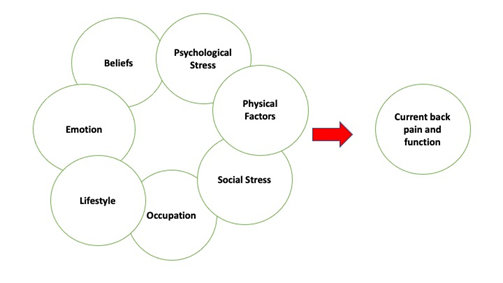 Chronic disabling low back pain is a significant issue, affecting both individuals and society, leading to substantial economic losses. Despite extensive research and significant investments, no definitive solution for chronic low back pain has been found, and the burden of this condition continues to grow.
Chronic disabling low back pain is a significant issue, affecting both individuals and society, leading to substantial economic losses. Despite extensive research and significant investments, no definitive solution for chronic low back pain has been found, and the burden of this condition continues to grow.
Many studies have predominantly focused on physical factors, such as the structures generating pain (i.e., disc, joint, nerve, etc.), trunk muscles, and sensitive and stiff joints and muscles. However, there is a growing body of evidence suggesting that a multidimensional approach encompassing more than just physical factors is required to achieve the best outcomes.
According to scientific research, various factors are critical to chronic pain, including sleep disturbances, pain-related fears and thoughts, general health, and psychological and social stress. Please look at the diagram below to see the multifactorial nature of low back pain (O’Sullivan et al. 2016).

A common example demonstrating the importance of your belief in your back pain is the fear-avoidance model (Leeuw et al. 2007). People with chronic low back pain often believe that bending forward is dangerous and could further damage their back. These thoughts and fears lead to avoidance of movement, causing them to stop bending forward and keep their back straight all the time, which consequently increases muscle tension around the trunk. Combined with the avoidance, this heightened tension can lead to poor health of the spine, contributing to more pain and disability. This reinforces their thoughts and beliefs, closing the vicious cycle (see the photo below).

In a multidimensional approach, physiotherapists not only address the tension and sensitivity of your spine but also guide you in restoring the avoided movements through movement therapy and appropriate education. This helps bring the function of the spine back to normal and improves your quality of life.
A recent publication in The Lancet, one of the most impactful medical journals, reported that the multidimensional approach generated significantly better outcomes compared to usual care. If you look at the graph below adopted from the research, you can clearly see that the multidimensional approach (Red and Grey lines) achieved greater outcomes than usual care (Blue line).

Moreover, contrary to popular belief, this approach required fewer sessions than usual care, demonstrating its economic benefits for both individuals and society.
Health on Grange Physiotherapy Clinic has decided to offer the multidimensional approach for people with chronic low back pain, aiming to restore your function and improve your quality of life. We warmly invite you to visit our clinic and experience our comprehensive care. Let us help you on your journey to better health.
Reference List
Kent, P, Haines, T, O’Sullivan, P, Smith, A, Campbell, A, Schutze, R, Attwell, S, Caneiro, JP, Laird, R, O’Sullivan, K, McGregor, A, Hartvigsen, J, Lee, D-CA, Vickery, A & Hancock, M 2023, ‘Cognitive functional therapy with or without movement sensor biofeedback versus usual care for chronic, disabling low back pain (RESTORE): a randomised, controlled, three-arm, parallel group, phase 3, clinical trial’, The Lancet, vol. 401, no. 10391, 2023/06/03/, pp. 1866-77.
Leeuw, M, Goossens, ME, Linton, SJ, Crombez, G, Boersma, K & Vlaeyen, JW 2007, ‘The fear-avoidance model of musculoskeletal pain: current state of scientific evidence’, J Behav Med, vol. 30, no. 1, Feb, pp. 77-94.
O’Sullivan, P, Caneiro, JP, O’Keeffe, M & O’Sullivan, K 2016, ‘Unraveling the Complexity of Low Back Pain’, Journal of Orthopaedic & Sports Physical Therapy, vol. 46, no. 11, 2016/11/01, pp. 932-37.
